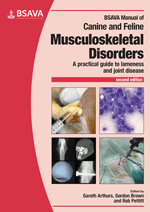
Full text loading...

Elbow disease is the most common cause of thoracic limb lameness in medium to large-breed dogs. This chapter covers clinical anatomy, clinical examination, diagnostic imaging, arthroscopy, surgical approaches to the elbow, elbow luxation, elbow dysplasia, incomplete ossification/intracondylar fissure-fracture of the humeral condyle, flexor enthesiopathy and salvage procedures for the elbow joint. Includes Quick Reference Guide to Imaging Techniques by Thomas W. Maddox. Operative Techniques: Arthroscopy of the elbow; Caudolateral approach to the elbow; Medial approach to the elbow; Subtotal coronoidectomy; OCD flap removal by medial arthrotomy; Closed reduction of traumatic lateral luxation; Collateral ligament repair; Dynamic proximal ulnar osteotomy/ostectomy; Ununited anconeal process internal fixation or removal; Lengthening of the radius.
The elbow, Page 1 of 1
< Previous page | Next page > /docserver/preview/fulltext/10.22233/9781910443286/9781910443286.19-1.gif

Full text loading...



















































